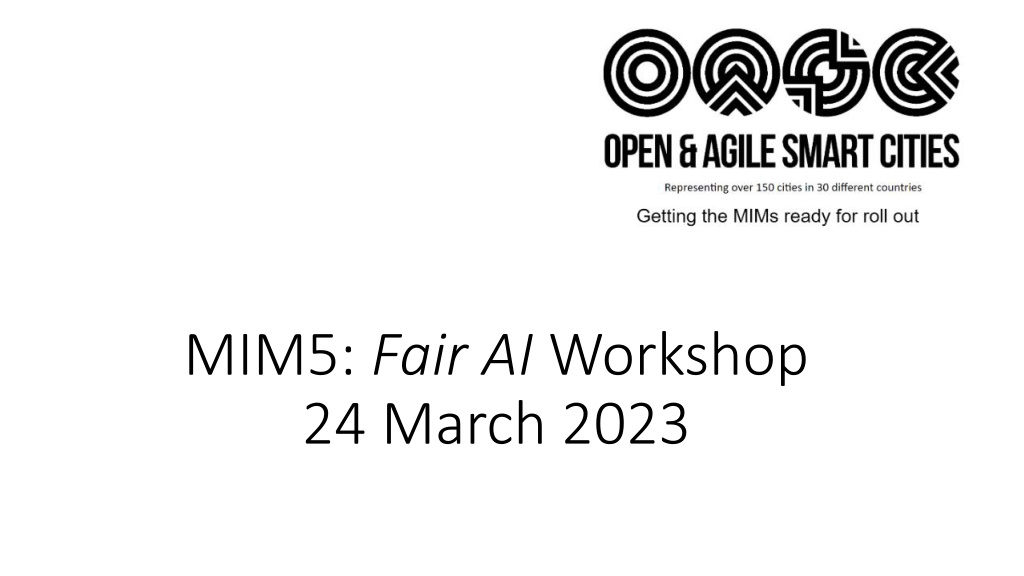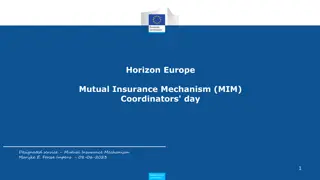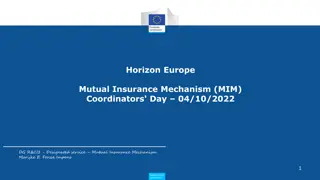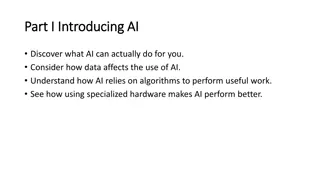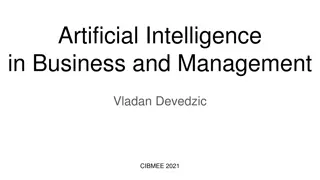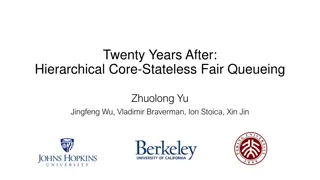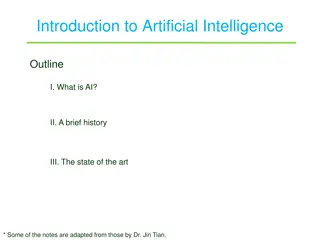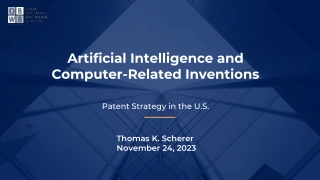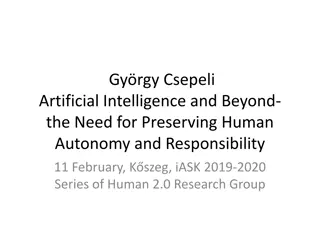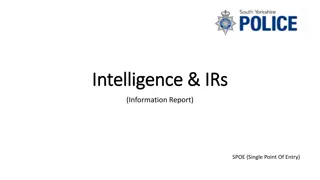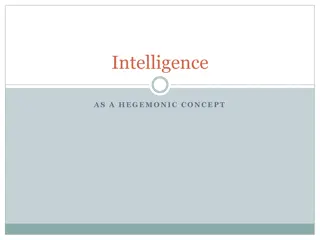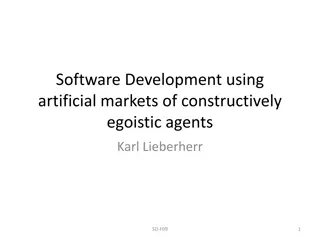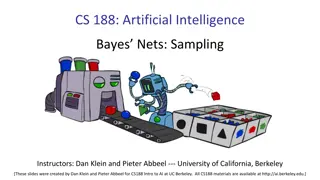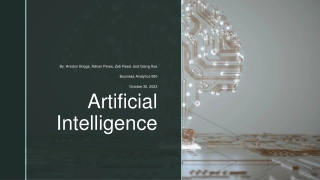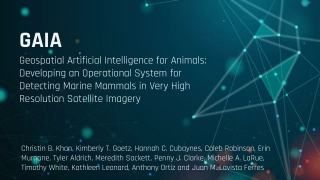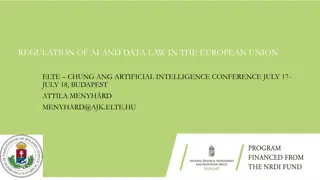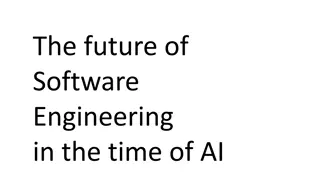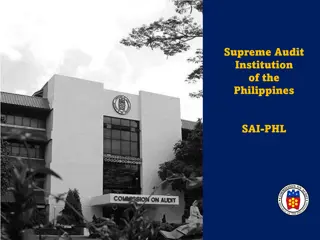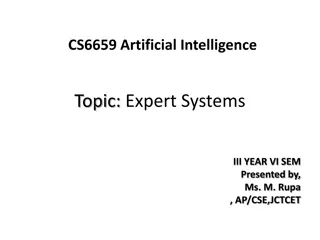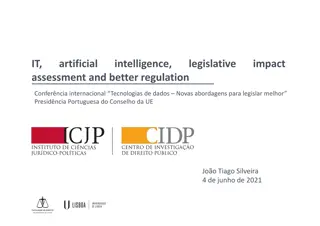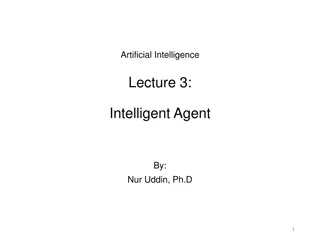MIM 5 Fair Artificial Intelligence Workshop Overview
The MIM 5 Fair Artificial Intelligence workshop focuses on providing technical tools and guidance to cities for procuring and utilizing fair and transparent AI. The session aims to ensure algorithmic systems meet requirements for fairness, trustworthiness, and transparency. It covers topics such as AI procurement clauses, workflow methodologies, and the technical foundation essential for urban data platforms worldwide.
Download Presentation

Please find below an Image/Link to download the presentation.
The content on the website is provided AS IS for your information and personal use only. It may not be sold, licensed, or shared on other websites without obtaining consent from the author. Download presentation by click this link. If you encounter any issues during the download, it is possible that the publisher has removed the file from their server.
E N D
Presentation Transcript
MIM5: Fair AI Workshop 24 March 2023
1. Welcome (3) 2. Purpose of the meeting (2 ) Review and update OASC MIM 5. Agree on timeline and milestones. 3. Tour de table (10 ) 4. Workshop part I (45 ) Status of MIM5 - Michael Mulquin. Eurocities AI registry Lodewijk Noordzee. AI procurement clauses. COFFEE BREAK (10 ) 4. Workshop part II (30 ) Work methodology (15 ). timeline of meetings, people to be involved, core and wider working group + roles & responsibilities. Q&A (15 ). 5. Any other business (5 ) 6. Closing (5 ) Next meeting, date time & location. Reminder of follow-up items. Agenda
Minimal Interoperability Mechanisms (MIM) are a universal tool for achieving interoperability of data, systems, and services between cities and suppliers around the world. They are based on an inclusive list of baselines and references, which takes into account the different backgrounds of cities and communities and allows cities to achieve interoperability based on a minimal common ground. The MIMs are developed by the OASC Technology Council and governed by the Council of Cities and the Board of Directors. They provide the technical foundation for procurement and deployment of urban data platforms and end-to-end solutions in cities and communities worldwide What is a MIM?
MIM Subject Name MIM1 Context Context Information Management MIM2 Data Models Shared Data Models MIM3 Contracts Ecosystem Transactions Management MIM4 Trust Personal Data Management The MIMs so far tackling the requirements of a local data ecosystem MIM5 Transparency Fair Artificial Intelligence MIM6 Security Security management MIM7 Places Geospatial information management MIM8 Indicators Ecosystem indicator management MIM9 Analytics Data Analytics Management MIM10 Resources Resource Impact Assessment
MIM 5 Fair Artificial Intelligence To provide technical tools and guidance to support cities in procuring and using fair and transparent AI. It will support the checks needed to use the contract clauses for procurement and align with the work on the Algorithm Registries
MIM 5 will provide the technical capabilities required to check that the algorithmic systems offered by suppliers comply with the requirements for fairness, trustworthiness and transparency identified by Amsterdam and by other checklists and standards. (The Working Group looked at a number of documents and we could review these in a future meeting) Objective
Technical resources to enable cities to check the set of six minimal requirements from Amsterdam for suppliers of algorithmic systems to ensure that these are fair, trustworthy and transparent. Procedural Transparency Technical Transparency Capabilities Technical Explainability Fairness Context Accountability
What is needed Identify/ develop a set of APIs that enable any potential algorithmic decision-making system to be queried as to: 1. Does the system use AI/ automated decision making? a. Yes/no, b. Which level? c. What schema is being used 2. What does the algorithms do? a. List of algorithms b. What schema is being used 3. Who certified this claim? a. Link to the certification based on a Registry of certified algorithms And to enable the claim to be checked by comparing the results from the use of the system with the results from a known system (for instance with human decision making) to ensure the results are accurate. Here the APIs need to check both the data sets being used and the algorithms.
Tasks for the MIM5 Working Group Review the Objective and Capabilities Review the Proposed Solution and transform this into a set of requirements See whether there are Open APIs or other technical solutions already developed that meet those requirement Develop any technical solution needed to meet any gaps Test with cities
Resources OASC Working Group plus Review Group CommuniCity technical team CitCom.AI TEF OASC Tech Council and Council of Cities Living-in.eu Tech subgroup Possibly ETSI or, if not, ITU
AI registry Lodewijk Noordzee Eurocities
AI procurement clauses From Amsterdam
Algorithmic System software that automatically makes predictions, makes decisions and/or gives advice by using data analysis, statistics and/or self-learning logic. The Guidelines need to be used when the decisions being made directly or indirectly by the algorithmic system are those that affect one or more citizens of the city, visitors to the city or companies or other institutions established in the city to a significant extent.
Procedural Transparency "the provision of information on the purpose of the Algorithmic System and the process followed in the development and application of the Algorithmic System and the data used in that context, which should in any event be deemed to include the provision of an understanding of the choices and assumptions made, the categories of data used in the development of the Algorithmic System, the way in which humanintervention is provided for in the Algorithmic System, the method used to identify risks, the risks identified, and the measures taken to mitigate the risks, as well as the parties that were involved in the development of the Algorithmic System and their roles."
Technical Transparency the provision of information enabling the city to understand the technical operation of the Algorithmic System, which may in any event be deemed to include the disclosure of the source code of the Algorithmic System, the technical specifications used in developing the Algorithmic System, the data used in developing the Algorithmic System, technical information on how the data used in developing the Algorithmic System were obtained and edited, information on the method of development used and the development process undertaken, substantiation of the choice for a particular model and its parameters, and information on the performance of the Algorithmic System.
Being able to explain on an individual level why an Algorithmic System leads to a particular decision or outcome. Unless the Parties expressly agree otherwise, this will in any event include a clear indication of the key factors that have led an Algorithmic System to a particular result and the changes to the input that must be made in order to arrive at a different result. Explainablity Making an Algorithmic System Explainable includes the provision of all the technical and other information required in order to explain, in objection proceedings, appeal proceedings or other legal proceedings, how a Decision has come about and to offer the other party and any other interested parties the opportunity to assess the way in which a Decision has come about, so as to offer the other party realistic legal protection.
Article 1 - Applicability Article 2 - Data quality Article 3 - Rights to the data Article 4 - Quality of the Algorithmic System Article 5 - Transparency of the Algorithmic System Article 6 - Risk management strategy in the development of the Algorithmic System Article 7 - Management of the Algorithmic System Article 8 - Audit or other type of inspection The 8 Articles covered by the guidelines
Applicability These terms and conditions will apply if the Contractor provides the city with an Algorithmic System to be used by the city when making or preparing Decisions or in the context of enforcement or fraud investigations. to be used to make or prepare Decisions on the city staff. They will apply regardless of whether Contractor provides the Algorithmic System to the city by way of a product, as part of a service or as part of a development agreement. If the Algorithmic System forms part of one or more software products that are jointly provided to the city by the Contractor, such software products will jointly constitute the Algorithmic System to which these terms and conditions apply, unless agreed otherwise between the Parties.
Data quality Whether or not the data is provided by the city, the Contractor will take the measures that may reasonably be expected of it to ensure that the data used in the development of the Algorithmic System will be analysed, structured and/or edited: a. according to a motivated approach, the purpose of which includes, without limitation, the avoidance of socially constructed distortion, inaccuracies, errors, mistakes, and undesired prejudice ("bias") in such data to the extent possible; b. in a manner that is in compliance with applicable laws and regulations.
Rights to the data All rights relating to the data to be provided by the city, and the data to be created or collected in the course of performance of the Agreement will accrue to the city. The Contractor will not be entitled to use such data for any purpose other than the performance of the Agreement. On demand of the city, the Contractor will destroy such data and/or hand over the data to the city. The data will be handed over in a common file format to be designated by the city. If, in order to convert the data to the file format desired by the city, the Contractor must perform additional work, the city will pay the Contractor a reasonable fee in that respect. On demand of the city, the Contractor will provide evidence of destruction of the data.
Quality of the Algorithmic System The Contractor represents that the Algorithmic System has been developed and will perform in a way that is in compliance with laws and regulations. The Contractor represents that the Algorithmic System has been developed according to a motivated approach. The Contractor represents that the Algorithmic System will perform accurately and correctly. The Contractor represents that the Algorithmic System is suitable for the Intended Use.
Transparency of the Algorithmic System On demand of the city: the Contractor will provide the city with Procedural Transparency. the city will be entitled to share the information provided by the Contractor in that context with third parties and to disclose it. the Contractor will complete a register for Algorithmic Systems to be designated by the city. the Contractor will provide the city with Technical Transparency in order to enable the city to carry out an audit
The city should at all times be able to explain the operation of the Algorithmic System (Explainability). Transparency of the Algorithmic System (2) The Contractor will be under the obligation to lend its full cooperation in making the Algorithmic System Explainable and to provide the city with all such information as may be required in that respect, the city will be entitled to share the information provided by the Contractor in that context with third parties and to disclose it.
Risk management strategy in the development of the Algorithmic System In the development of the Algorithmic System, the Contractor will pursue a common and up- to-date risk management strategy that is appropriate for the nature of the Algorithmic System. The Contractor will identify the main risks that may occur when the city uses the Algorithmic System and take measures to make the identified risks manageable. The Contractor will implement and document the risk management strategy in such a way that the audit can verify whether the Contractor has performed that obligation If and to the extent that the Contractor has developed the Algorithmic System prior to conclusion of the Agreement, the Contractor warrants that the measures described have already been taken. The Contractor will produce evidence thereof on demand of the city.
Management of the Algorithmic System If the Contractor offers the Algorithmic System by way or as part of a service or provides management and maintenance services in respect of the Algorithmic System, the Contractor warrants that the Algorithmic System and the related documentation will continue to comply with the conditions set out throughout the term of the Agreement. If the Contractor offers the Algorithmic System by way or as part of a service or provides management and maintenance services in respect of the Algorithmic System, the services to be provided by the Contractor will include continuous monitoring by the Contractor, throughout the term of the Agreement, whether the risks are still up to date and whether the risk management measures are effective. If not, the Contractor will take additional measures. As part of the obligation, the Contractor will provide information if new risks become known or if the measures to mitigate the risks prove to be ineffective.
Audit or other type of inspection The Contractor will at all times be under the obligation to lend its cooperation in an audit or other type of inspection to be carried out by or on behalf of the city to assess whether the Contractor complies with the conditions set in the Agreement. Such cooperation will include providing Technical Transparency, providing Procedural Transparency, providing an insight into the risk management strategy implemented, making Contractor staff available for conducting interviews and providing access to the locations of the Contractor. the city will prepare, or cause the preparation of, a report in which the conclusions of the audit will be recorded. In the report, the city will record the extent to which the Contractor complies with the obligations under the Agreement. If the city establishes that the Contractor does not comply with the obligations under this article, the Contractor will be under the obligation to remedy the defects identified by the city within the reasonable term set by the city in the report. If the Contractor fails to remedy the defects identified by the city within the term for remedying such defects set in the report, the Contractor will be in default by operation of law. the city will be entitled to publish the conclusions of the audit report. the city will be entitled to perform, or cause the performance of, an audit once per calendar year. the city may decide to have all or part of the audit performed by an independent auditor.
Questions? Comments?
